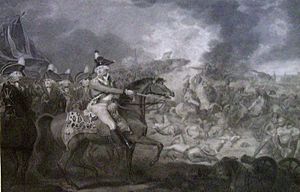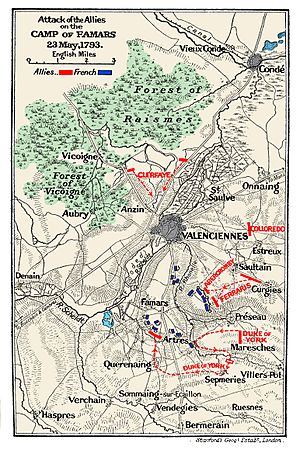Battle of Famars facts for kids
Quick facts for kids Battle of Famars |
|||||||
|---|---|---|---|---|---|---|---|
| Part of the Flanders campaign in the War of the First Coalition | |||||||
 Battle of Famars |
|||||||
|
|||||||
| Belligerents | |||||||
| Commanders and leaders | |||||||
| Strength | |||||||
| 27,000 | 53,000 | ||||||
| Casualties and losses | |||||||
| 3,000 killed or wounded, 300 captured, 17 cannons lost, 14 ammunition wagons, 3 standards lost |
ca 1,100 killed or wounded | ||||||
The Battle of Famars was a big fight that happened on May 23, 1793. It was part of the War of the First Coalition, a major conflict in Europe. In this battle, an army made up of soldiers from Austria, Hanover, and Britain fought against the French army.
The Allied forces were led by Prince Josias of Saxe-Coburg-Saalfeld. The French Army of the North was led by François Joseph Drouot de Lamarche. The battle took place near a small village called Famars in northern France. This village is about five kilometers south of Valenciennes. The Allied army won this battle.
Contents
Why did the Battle of Famars happen?
In May 1793, the French army was having a very tough time. They had lost many battles and their soldiers were tired. Their previous commander had died, and the army was disorganized. Many soldiers were also sent away to fight in another conflict in France called the war in the Vendée.
Even though new soldiers were joining, many of them left or were not ready to fight. The new French commander, Lamarche, knew his army needed to rest. He decided to move his troops to a strong camp at Famars. This camp was near the fortress of Valenciennes.
The Allied forces, led by Prince Coburg, wanted to attack Valenciennes. But first, they needed to get rid of the French army at Famars. This would clear the way and stop the French from interfering. New British and Hanoverian troops had just arrived. They were led by Frederick, Duke of York, who was only 26 years old.
It was decided that these new troops would lead the main attack. This was a bit surprising because many of the British soldiers had never fought against the French before.
The Famars camp was on a hill, about three miles south of Valenciennes. A river called the Rhonelle was on its eastern side. All the bridges and places to cross the river had been destroyed. An Austrian officer named Karl Mack von Leiberich planned the attack. The plan was to attack the eastern side of the camp directly. Two main groups of soldiers would do this. Two smaller groups would also attack the sides to keep the French busy.
What happened during the battle?
The main attack force had 16 battalions (groups of soldiers) and 18 squadrons (groups of cavalry). This force was led by the Duke of York. It included the British Guards, who had already fought in a battle on May 8. The plan was for York's troops to cross the Rhonelle river using temporary bridges. Then, they would attack the French camp from its right side.
Another main attack force was led by an Austrian general, Joseph de Ferraris. This group had 12 battalions and 12 squadrons. It included British soldiers from the 14th and 53rd Foot regiments. Their job was to attack from the village of Saultain. They would target the French defenses on the east side of the Rhonelle river.
Two smaller groups also attacked. One, led by Wenzel Joseph von Colloredo, attacked the northeast side of Valenciennes. The other, led by Rudolf Ritter von Otto, threatened a town called Le Quesnoy.
The Duke of York's group started moving around 2:00 AM. But a very thick fog made them slow down. They only reached the Rhonelle river at 7:00 AM. When the fog lifted, they saw French soldiers and cannons waiting for them. The French immediately started firing.
General Mack, who planned the attack, was hurt right away. So, the young Duke of York had to decide what to do next. He chose to turn his troops and march towards Maresches, a village two miles to the southeast. He left some Austrian cannons and soldiers behind to keep the French busy.
York's troops crossed the river at Maresches without any trouble. His light cavalry rode up a small hill to check the French side near Querenaing. However, there were many delays and traffic jams at Maresches. It was 3:00 PM before York's troops were clear of the village. This gave the French plenty of time to turn and face the new threat. It was 5:00 PM when York finally reached Querenaing after taking a long route.
However, the British cavalry moved behind the French defenses that were open at the back. Their patrols even reached almost to the Abbey of Fontanelle, which was behind the French position. The Allied cavalry had some success. They entered the open French forts and defeated the defenders. The French cavalry tried to take back these forts but were pushed away.
Meanwhile, further north, Ferraris's group had successfully attacked the French defenses on the east side of the Famars position. They pushed the French soldiers back to the west side of the Rhonelle river. Earlier that day, some French cavalry had tried to attack Ferraris's side. But Hanoverian cavalry charged them and defeated them after a tough fight.
Finally, York was ready to launch his main attack. But a cautious general named Hohenlohe stopped him. He said the soldiers were too tired. So, York had to wait until the next morning to attack.
Even though the French held their ground in the north, Lamarche realized his army was in danger. He left some soldiers to defend Valenciennes. During the night, the French army quietly pulled back towards Bouchain and other areas. The next morning, when York attacked, the French had already left. Colloredo's group from the north was the first to enter the empty French camp.
What happened after the battle?
Another Allied general, Clerfayt, also won his attack. He faced tougher fighting at Mont Anzin but was successful.
The French army had about 27,000 soldiers in the battle. They lost about 3,000 soldiers who were killed or wounded. The Allies captured 300 French soldiers, 17 cannons, 14 ammunition wagons, and three flags. The Allied forces had about 53,000 soldiers. They lost about 1,100 soldiers who were killed or wounded, mostly Austrians. General Mack, who planned the attack, was among those wounded. The Hanoverian troops lost 22 killed and 61 wounded.
With the Famars camp cleared, Prince Coburg could now start the Siege of Valenciennes. The Duke of York was again given the main role in leading this siege.
On May 27, Lamarche was replaced as the French commander by Adam Philippe, Comte de Custine.
During the battle, the 14th Regiment of Foot, a British army group, attacked the French while playing the tune of Ça Ira. This regiment was later given the honor of using this tune as a battle honor and their quick march song.
Was the Duke of York blamed?
Some Austrian commanders blamed the Duke of York for not catching Lamarche's army. But British historians, like Alfred Burne, disagree. They say a good commander should be flexible and change plans if needed. York changed his plan when he saw the French waiting for him. He found another way to attack.
Historians believe that the Duke of York should be praised for being flexible. He did not just stick to the first plan even when it was clear it would not work. This shows he was a smart leader.
Images for kids



